
| Back to 1997 Indiana Report of Diseases |
Cases
= 564Crude rate
(per 100,000 population) = 10.2Age-adjusted race-specific rates
(per 100,000 population)Gender-specific rates
(per 100,000 population)Campylobacteriosis is a bacterial disease usually transmitted through raw or undercooked foods of animal origin, or through foods cross contaminated by animal products. It can also be transmitted person-to-person.
There were 564 cases of campylobacteriosis reported in Indiana in 1997, which represents a 20% reduction from the 1996 level (Figure 1).
Figure 1.

Incidence of disease was greatest during the summer months, as shown in Figure 2.
Figure 2.

There was little difference in rates by gender, but the age-adjusted rate for whites (6.8) was 1.9 times higher than that for nonwhites (3.5). Age-specific rates were greatest among infants (22.5) followed by preschoolers (9.8) (Figure 3).
Figure 3.
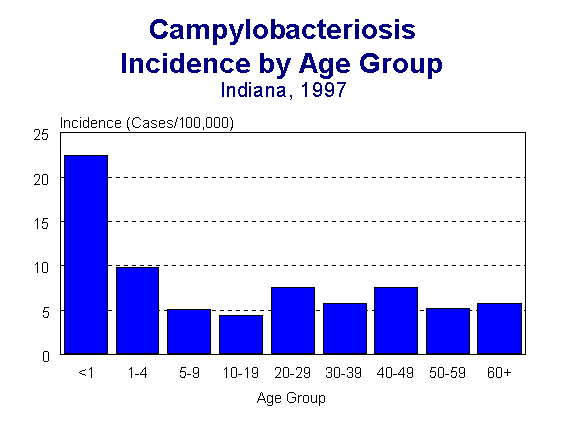
There were no outbreaks of campylobacteriosis reported in Indiana in 1997.
Infection With ESCHERICHIA COLI O157:H7
Cases
= 75Crude rate
(per 100,000 population) = 1.4Age-adjusted race-specific rates
(per 100,000 population):Gender-specific rates
(per 100,000 population)Escherichia coli O157:H7 infection is a bacterial disease usually transmitted through raw or undercooked foods of animal origin, or through foods cross contaminated by animal products. It has most commonly been associated with raw or undercooked hamburger. Outbreaks have also been attributed to unwashed produce, unpasteurized fruit juices, and swimming in or drinking untreated surface water. It can also be transmitted from person-to-person and is a special concern in the day care center setting.
There were 75 reported cases of E. coli O157:H7 in Indiana in 1997, which marks the first decrease in reported incidence since E. coli O157:H7 became legally reportable in 1994 (Figure: Ecolyear.prs). It is recommended that all clinical laboratories routinely screen all stool specimens for sorbitol-negative E. coli. Lack of sorbitol fermentation in E. coli is a biochemical marker for the O157:H7 type. The ISDH Laboratory provides free confirmation services for all sorbitol-negative E. coli isolates.
Generally, incidence was greatest during the summer and early autumn months (Figure 1).
Figure 1.

There was little difference in rates of E. coli O157:H7 infection by sex. Age-specific rates were greatest among children aged one to four (4.3) which highlights the increased risk for transmission in day care centers (Figure 2). Transmission in day care centers can be avoided through exclusion of children with diarrhea and good everyday hand washing practices.
Figure 2.

The ISDH investigated one confirmed E. coli O157:H7 outbreak in 1997. In October, six Vanderburgh County children were infected with E. coli O157:H7 following a field trip to a local apple orchard and cider pressing operation. None of the children developed HUS. This outbreak is described in more detail in Appendix E.
Cases
= 706Crude rate
(per 100,000 population) = 12.7Age-adjusted race-specific rates
(per 100,000 population)Gender-specific rates
(per 100,000 population):
Transmission
Giardiasis is a flagellate protozoan infection transmitted most commonly by ingestion of cysts in fecally-contaminated water and from person-to-person by hand-to-mouth transfer of cysts from the feces of infected individuals.
Incidence of giardiasis decreased slightly in 1997 after holding relatively stable for the past several years (Figure 1).
Figure 1.

The number of reported cases was highest during the late summer and early autumn months (Figure 2). The increase during warm weather months may indicate increased exposure to contaminated surface water during outdoor activities.
Figure 2.
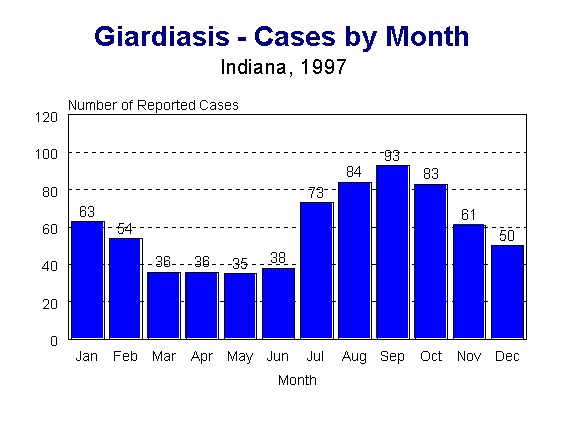
While the rate of giardiasis infection by gender was similar, the age-adjusted rate of giardiasis was almost 2 times higher for whites than nonwhites.
Figure 3 shows that the age-specific rates were highest among children aged one to four years (32.7), followed by children under age one (16.9). Nationally, outbreaks of giardiasis have been occurring with more frequency in day care centers.
Figure 3.

Crude incidence rates of giardiasis were highest in Steuben (61.9), Tipton (55.8), and Huntington (42.3) counties.
Cases
= 327Crude rate
(per 100,000 population) = 5.9Age-adjusted race-specific rates
(per 100,000 population):Gender-specific rates
(per 100,000 population):Hepatitis A is transmitted most commonly from person to person via fecally-contaminated hands, food, water, or other objects.
In 1997, hepatitis A incidence in Indiana decreased slightly from the previous year but still remained higher than the 1995 level, a year in which the incidence of hepatitis A was particularly low (Figure 1).
Figure 1.
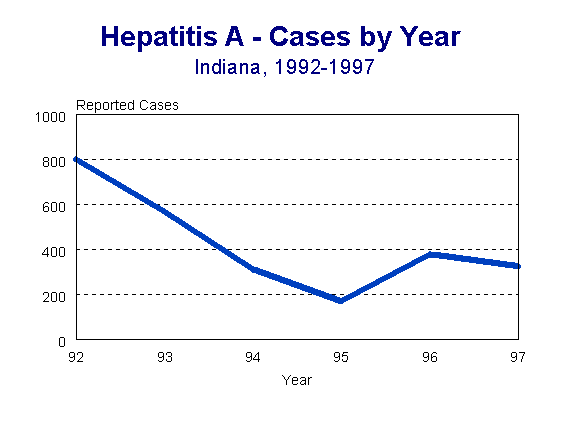
Whites were over 3 times more likely than non-whites to be reported with hepatitis A in 1997. Men were almost 2 times more likely to become infected than females. The age-specific incidence was highest among children aged 5 to 9 years (6.8) and adults aged 30 to 39 years (6.7) (Figure 2). Children under the age of five are less likely to be reported than adults because they are less likely to be symptomatic.
Figure 2.

There was no clear seasonal trend although the number of reported cases was greatest during the months of March (13%) and October (12%) (Figure 3).
Figure 3.

Sullivan (121.1), Knox (47.6), and Wabash (42.8) counties had the highest crude incidence rates of Hepatitis A in 1997. Both Sullivan and Wabash counties experienced propagated community outbreaks. In May, a propagated outbreak occurred in Knox County began when eight elementary school students were diagnosed with hepatitis A. Transmission then occurred in the general community for the next several months. One foodborne outbreak of hepatitis A occurred in Elkhart County. All hepatitis A outbreaks are described in further detail in Appendix E.
Approximately one-fourth of the interviewed cases had been in contact with a known case of hepatitis A. Of the more common risk factors for hepatis A, exposures to day care centers, international travel, and eating raw shellfish were more common than male homosexual or bisexual contact, having multiple sexual partners, and intravenous drug use. Twenty-three (9%) of the interviewed cases were employed as foodhandlers during their infections. The reported risk factor data were summarized in Table 1.
Table 1. |
||
| Risk Factor | Number Cases | Total (%*) |
|---|---|---|
| Day care attendee/employee | 18 (7%) | |
| Contact with a day care center attendee/employee |
21 (8%) | |
| Contact with a confirmed case Sexual Household Other |
 6 33 29 |
68 (27%) |
| Employed as a foodhandler | 23 (9%) | |
| Ate raw shellfish | 14 (6%) | |
| International travel Central/South America Africa Caribbean Middle East Asia Other |
11 0 7 1 1 11 |
31 (12%) |
| IV drug use | 7 (3%) | |
| Male homosexual or bisexual contact | 9 (4%) | |
| More than 1 sexual partner w/i 50 days prior to illness |
2 (1%) | |
| *Percent of 254 cases who were interviewed. Multiple risk factors possible. | ||
Cases
= 587Crude rate
(per 100,000 population) = 10.6Age-adjusted race-specific rates
(per 100,000 population)Gender-specific rates
(per 100,000 population)Salmonellosis is a bacterial disease usually transmitted through raw or undercooked foods of animal origin or foods cross contaminated by animal products or feces. It can also be transmitted person-to-person.
(Figure 1) shows the distribution of serotypes of Salmonella cultured from initial and reference specimens submitted to ISDH Enterics Laboratory.
Figure 1.

There are over 2300 different Salmonella serotypes that differ in somatic and flagellar antigens. During 1997, serotype was determined for 87% of the reported Salmonella cases. Of the 510 Salmonella isolates of known serotype, 172 (34%) were typhimurium, 103 (20%) were enteritidis, 19 (4%) were heidelberg, 19 (4%) were newport, and the remaining 182 (36%) were other serotypes.
Incidence of salmonellosis in Indiana remained stable with 587 cases being reported (Figure 2). The incidence was greatest during the summer months (Figure 3).
Figure 2.

Figure 3.

There was little difference in the rates of salmonellosis by race or sex. Overall age-specific rates were greatest among infants (57.8) followed by preschoolers (17.4) (Figure 4).
Figure 4.

Among counties with at least 5 reported cases, crude incidence rates of salmonellosis were greatest in Lawrence (23.3), Montgomery (23.2), LaPorte (22.4), Warrick (22.3), and Porter (20.2) counties.
One outbreak of Salmonella Group B was reported in 1997. The Boone County outbreak occurred in November and was associated with a catered Thanksgiving dinner. The outbreak is described in more detail in Appendix E..
In response to increasing numbers of multi-drug resistant Salmonella typhimurium DT104 in Europe and parts of the US, the ISDH Disease Control Laboratory began screening all S. typhimurium isolates for resistance to those antibiotics for which the European DT104 strain commonly shows resistance. These included ampicillin, chloramphenicol, streptomycin, sulfonamides, and tetracycline. Of the 161, S. typhimurium isolates examined, 72 (45%) of the isolates showed identical resistance patterns to that shown by the European DT104 strain (Figure 5).
Figure 5.
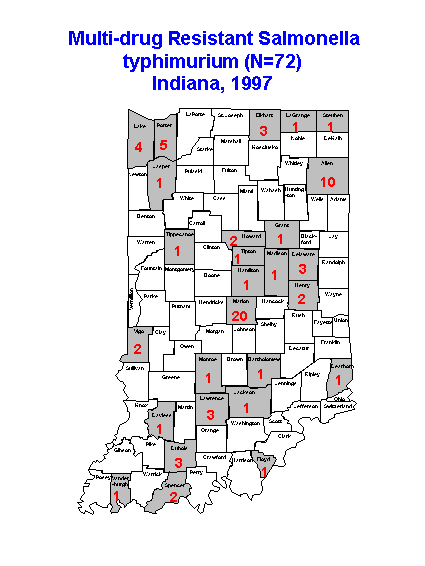
Twelve of these drug resistant isolates represented distinct clusters associated by geography and time (Figure 6). These 12 cluster associated isolates were forwarded to the CDC where phage typing indicated that all were S. typhimurium DT104.
Figure 6.

Cases
= 93Crude rate
(per 100,000 population) = 1.7Age-adjusted race-specific rates
(per 100,000 population)Gender-specific rates
(per 100,000 population)Shigellosis is a bacterial disease usually transmitted from person-to person through hands contaminated with feces. It can also be transmitted through food and water contaminated with human feces, or oral-anal sexual practices.
There are four Shigella species, all of which infect only humans. Only 10-100 organisms must be ingested to establish an infection. The serotype was determined for 84 (90%) of the 93 reported shigellosis cases. Shigella sonnei accounted for 68 (81%) of the reported serotypes while the remaining 16 (19%) were S. flexnerii.
Shigellosis incidence in Indiana has been decreasing steadily for the past four years following 1993, a year in which the shigellosis incidence was particularly high (Figure 1).
Figure 1.
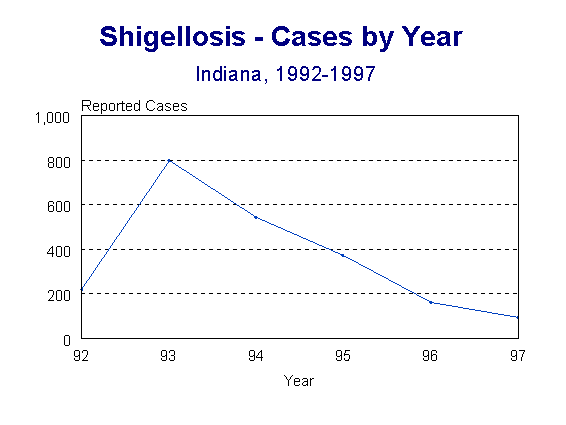
Incidence of shigellosis followed a bimodal distribution with most cases occurring during the summer and winter months (Figure 2).
Figure 2.
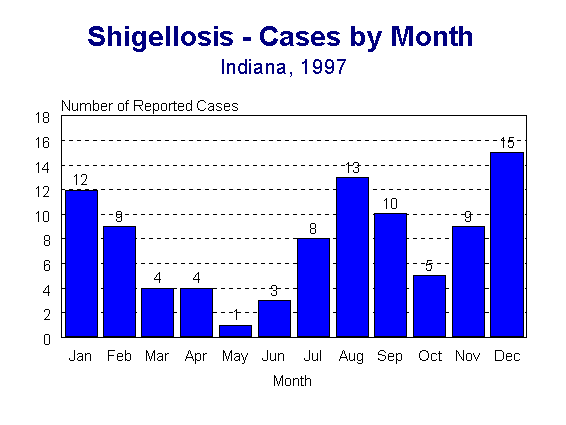
There was little difference in the incidence rate for males (1.5) and females (1.9). The age-adjusted rate of shigellosis was 2 times greater for nonwhites than whites.
Age-specific rates were highest among children aged one to four years (4.0), followed by children aged five to nine years (2.4) (Figure 3: shigage.prs). These high age-specific rates of shigellosis among preschool-aged and elementary school aged children represent the increasing problem of shigellosis outbreaks in day care centers and certain segments of elementary schools, primarily up through first graders.
Figure 3.

Crude incidence rates of shigellosis were greatest in Posey (19.3), and Floyd (18.6) counties.
| Back to 1997 Indiana Report of Diseases |